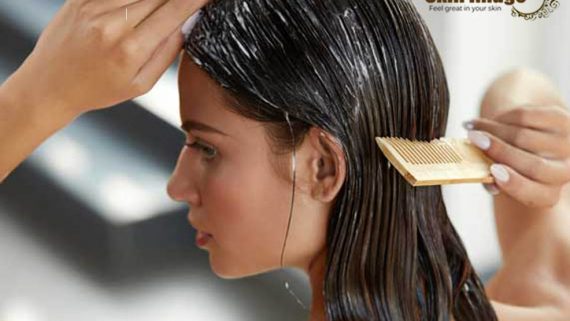About SCALP: Scalp consists of five layers. It’s extremely absorbent because it contains so many hair follicles. There are 650 sweat glands, 1000 nerve endings and 20 blood vessels alone on your head, so penetration is greater and it has the potential to get rapidly absorbed straight into the bloodstream. It’s one of the reasons that your hair is commonly used for drug testing and toxin analysis like lead and mercury poisoning.
If you’re a frequent hair washer (more than twice a week), the shampoos and conditioners you use should be high on your list of detox priorities and you should scrutinise the labels of products you use. As well as the overall hazard score on hair products, it’s important to check out and evaluate the biodegradability of the ingredients. Keep in mind that whatever you’re washing and cleaning your hair with, will end up in overburdened and polluted water ways.
About HAIR: Your hair is made up of a protein called keratin. The outer layer is called the cuticle. Up close, it has a scaly appearance like a fish. Its role is to protect the hair shaft. The pH of the hair is low, around three. When it’s washed with harsh surfactants, the acid balance is destroyed because the pH is so much higher.
To restore the appearance of the cuticle so that it has a lovely smooth, shiny appearance that reflects light and makes the hair lie flat and look healthy, will require conditioning agents. If you want to balance your scalp and reset to a healthier hair regime, start with washing your hair less frequently.
Ingredients to look out for
SURFACTANTS: A big misconception in haircare is that foam is an indicator of cleanliness. Foaming isn’t healthy. In fact, the less foam, the better. Most shampoos contain synthetic foaming agents known as surfactants. These are compounds that reduce the surface tension of liquids and help suspend oil and dirt, making them easier to remove or clean from the hair, body or greasy surfaces.
ETHOXYLATION: A common chemical process used in creating surfactants is ethoxylation. It involves adding ethylene oxide to an alcohol or phenol to create the surfactant. A concerning by-product of this manufacturing process is contamination of 1,4-dioxane, a known carcinogenic byproduct. The simplest way to identify if an ingredient has been ethoxylated is to look for ‘eth’ in the name.
SULPHATES/SULFATES: Mainstream shampoos often contain sulphates. These are commonly found in almost all foaming and lathering products. Although these ingredients may originate from coconuts, the final product is far from its natural starting point.
AVOID: SODIUM LAURETH SULFATE (SLES), SODIUM LAURYL SULFATE (SLS), AMMONIUM LAURETH SULFATE (ALES) AND AMMONIUM LAURYL SULFATE (ALS)
ALTERNATIVE: DECYL, CAPRYL, COCO AND LAURYL GLUCOSIDES
CONDITIONERS & COATING AGENTS: To achieve the sort of finish found in
Haircare advertisements, most Haircare products contain silicones or plastic derivatives. They’re designed to coat the hair shaft, making it appear luxurious and healthy. While the result may look fabulous, they prevent transpiration and penetration of nutrients. They build up in the hair and the environment. Regardless of whether a label states the product is full of proteins or vitamin E, your hair is essentially dead, so it isn’t going to make a difference to the hair shaft.
AVOID: SILICONES – DIMETHICONE, POLYMETHYLSILOXANE
ALTERNATIVE: ISOAMYL LAURATE, PLUKENETIA VOLUBILIS SEED OIL, JOJOBA, ARGANIA SPINOSA ARGAN KERNAL OIL, MORINGA SEED OIL, SHEA BUTTER
If you are suffering from hair fall you may contact us at Skin Image Clinic Faridabad for consultant hair and skin related issue.


Leave a Reply